ISS: NanoRacks-QB50
EO
Quick facts
Overview
| Mission type | EO |
| Launch date | 18 Apr 2017 |
ISS Utilization: NanoRacks-QB50
Launch Mission Status Sensor Complement Background of the QB50 CubeSat Constellation References
The NanoRacks-QB50 project uses the International Space Station to deploy a constellation of 28 CubeSats to study the upper reaches of the Earth's atmosphere over a period of 1 to 2 years. This constellation is the result of an international collaboration involving academia and research institutes from 23 different countries around the world. The project, coordinated by the QB50 Consortium, receives funding from the European Union's Seventh Framework Program for Research and Technological Development. The QB50 satellites conduct coordinated measurements on a poorly studied and previously inaccessible zone of the atmosphere referred to as the thermosphere. The project monitors different gaseous molecules and electrical properties of the thermosphere to better understand space weather and its long-term trends. 1)
Research Overview
• NanoRacks-QB50 has the following four objectives that include facilitating access to space, carrying out a scientific measurement campaign with a satellite constellation to probe the middle and lower thermosphere, demonstrating new technologies in orbit, and promoting space engineering and science education.
• The mid-lower thermosphere (400 km to 200 km altitude) is largely unexplored and only few measurements exist below 300 km altitude. The QB50 project constellation is the first ever mission to target such altitudes with a large number of atmosphere sensors.
• QB50 offers the opportunity to have multi-point measurements of the thermosphere with a unique space and time resolution.
• A synchronized data acquisition among the sensors of the constellation allows the observation of fast travelling and small scale waves in the thermosphere.
• The scientific database is used to validate and enhance global atmosphere models and improve the understanding of physical processes which are taking part in the ionosphere-thermosphere coupling.
Description: The NanoRacks-QB50 mission presents a number of firsts and unique opportunities for the scientific community. The different launch inclinations, altitudes and timings mean that the CubeSats spread out throughout the thermosphere, along the International Space Station (ISS) orbit, and along the proposed Polar Satellite Launch Vehicle (PSLV) launch orbit, providing a widely-spread network of sensors in longitude and latitude. The two differently timed launches from the ISS and the separate PSLV launch also provide a spread in the altitude of the CubeSats. The spread in location and in altitude of the sensors will allow the first ever real-time coordinated study of the thermosphere resolved in space, altitude and time on a global scale.
The QB50 observations can be coordinated with the current cutting edge observations of the thermosphere from the many other sources discussed above. Knowing the orbits of the CubeSats it is possible to time the collection of data using these other techniques.
This has several advantages; the QB50 observations are calibrated against the external observations, the spatial and temporal changes observed by QB50 can be distinguished from one another (the CubeSats travel a distance along their orbit in a given time and so variations in space appear as variations in time in single satellite data, an external data source showing the spatial or temporal changes in a fixed region helps distinguish the two). The mission flies for a period between 12 and 24 months and can thus supply a calibrated monitor of the longer-term changes in the thermosphere, be that seasonal, annual or perhaps related to climate change. If the ideal case of the CubeSats operating continuously can be achieved, then QB50 will provide the longest continual in-situ measurement of the thermosphere.
Launch
The Cygnus CRS (commercial Resupply Services) OA-7 capsule was launched on April 18, 2017 (15:11 UTC) by ULA (United Launch Alliance) on an Atlas-5 401 vehicle from the Air Force Station SLC-41, at Cape Canaveral,FL. — Prior to launch, the CRS OA-7 mission was given the name S.S. John Glenn, in honor of astronaut and senator of Ohio, John Glenn, the first US astronaut to orbit the Earth on Mercury 6 and the oldest to go to space on STS-95. John Glenn passed away in December 2016 at age 95. 2) 3)
Operational Requirements and Protocols: The NanoRacks-QB50 CubeSats were delivered to the ISS already integrated within a NanoRacks CubeSat Deployer (NRCSD). Onboard of ISS, a crew member will transfer each NRCSD from the launch vehicle to the JEM/Kibo. Visual inspection for damage to each NRCSD will be performed. When CubeSat deployment operations begin, the NRCSDs are unpacked, mounted on the JAXA MPEP (Multi-Purpose Experiment Platform) and placed on the JEM airlock slide table for transfer outside the ISS. A crew member operates the JRMS (JEM Remote Manipulating System) – to grapple and position for deployment. The CubeSats are deployed, when the JAXA ground controllers command a specific NRCSD.
Orbit: Near-circular orbit, altitude of ~ 400 km, inclination of 51.6º (β angle variation: 0-75º).
This file is seen as a supplementary to the file: "ISS: Cygnus CRS OA-7 mission of Orbital ATK" on the eoPortal — which contains all payloads of the flight.
List of QB50 x 28
Twentyeight CubeSats of the international QB50 constellation, a European FP7 (7th Framework Program) Project for Facilitating Access to Space and managed by the Von Karman Institute for Fluid Dynamics in Brussels, Belgium, were flown to the ISS for subsequent deployment (atmospheric research). The 28 CubeSats (all 2U except one with a 3U form factor) of the QB50 constellation were integrated into 11 NanoRacks 6U deployers. 4) 5) 6)
Note: The satellites will eventually be deployed into LEO over a period of 30 to 60 days as the ISS orbits the Earth.
- Aalto-2 of Aalto University, Aalto, Finland is hosting the m-NLP (Multi-Needle Langmuir Probe) payload.
- Aoxiang-1 of NPU (Northwestern Polytechnical University), China/Belgium, carries a FIPEX (Flux-Phi Probe Experiment) payload.
- Atlantis of the University of Michigan,USA carries a FIPEX payload.
- BeEagleSat of Istanbul Technical University and Halvesan (a defence contractor in Turkey owned by the government) carries a m-NLP payload.
- Challenger of the University of Colorado, Boulder, CO, carries an INMS payload.
- Columbia, built by the Universidad del Turabo, Gurabo, Puerto Rico/USA, carries a FIPEX payload.
- ExAlta-1 (Experimental Albertan-1), a 3U CubeSat of the University of Alberta, Canada, is equipped with m-NLP.
- DUTHSat was built by the University of Thrace, Greece. It features the M-NLP payload.
- HAVELSAT of Istanbul Technical University and Halvesan (a defence contractor in Turkey owned by the government); it carries the m-NLP payload.
- Hoopoe, of the Herzliya Science Center, Israel, is equipped with the m-NLP payload. The CubeSat, named for Israel's national bird, the Duchifat-2 (in English, Hoopoe-2), was built by Israeli high school students. More than 80 Israeli teenagers from around the country—in grades 9-12—came to Herzliya Science Center to help build the tiny 1.8 kg 2U CubeSat, a type of miniaturized satellite for space research. 7)
- INSPIRE-2 of the University of Sydney, Australia, features the m-NLP payload.
- LilacSat-1 of HIT (Harbin Institute of Technology), China/Belgium, carries the INMS (Ion-Neutral Mass Spectrometer) payload.
- LINK (Little Intelligent Nanosatellite of KAIST), Korea, is equipped with an INMS payload.
- NJUST-1 of Nanjing University of Science and Technology, China/Belgium, is equipped with an INMS payload.
- nSIGHT-1, developed by SCS-Space of Cape Town, South Africa. The CubeSat carries the FIPEX payload.
- PHOENIX of the National Cheng Kung University, Taiwan, carries an INMS payload.
- PolyITAN-2-SAU of the National Technical University, Ukraine, carries a FIPEX payload.
- qbee50-LTU-OC of the Lula University of Technology, Sweden, and partner Open Cosmos Ltd of England carries a FIPEX payload.
- QBITO of the Universidad Politécnica de Madrid, Spain, carries an INMS payload.
- SNUSat-1 and SNUSat-1B of the Seoul National University, Korea, both satellites carry the FIPEX payloads.
- SOMP-2 (Student's Oxygen Measurement Project 2) of the Technical University of Dresden, Germany, features the FIPEX payload.
- SpaceCube was built by Ecole des Mines Paristech of France; it carries the m-NLP payload.
- SUSat of the University of Adelaide, Australia, the CubeSat features an INMS payload.
- UNSW-ECO of the University of New South Wales, Australia. It is equipped with the INMS payload. - In addition, the UNSW-ECO features a total of four experiments including a GPS receiver, and two boards testing radiation-robust software and self-healing electronics. The fourth experiment is to test the satellite's chassis, built using a 3D-printed material never before flown in space. 8)
- UPSat was built by the University of Patras (Greece) and the Libre Space Foundation. UPSat is the first CubeSat to be based on open-sources software. DUTHSat it featues the m-NLP (Multi-Needle Langmuir Probe) payload.
- X-CuveSat was built by the Ecole Polytechnique, the CubeSat carries the FIPEX payload.
- ZA-AeroSat, developed by Stellenbosch University, Stellenbosch, South Africa. It carries the FIPEX payload.
The NanoRacks-QB50 project uses the ISS to deploy a constellation of 28 CubeSats, from a total of 36, in order to study the upper reaches of the Earth's atmosphere over a period of 1 to 2 years. This constellation is the result of an international collaboration involving academia and research institutes from 23 different countries around the world. The project, coordinated by the QB50 Consortium, receives funding from the European Union's Seventh Framework Program for Research and Technological Development. The QB50 satellites conduct coordinated measurements on a poorly studied and previously inaccessible zone of the atmosphere referred to as the thermosphere. The project monitors different gaseous molecules and electrical properties of the thermosphere to better understand space weather and its long-term trends. 9)
Mission Status
• April 27, 2023: The International Space Station (ISS) partners have agreed to extend the operational period of the ISS. The United States, Japan, Canada and participant European Space Agency (ESA) countries will support operations until 2030, while Russia has committed to continuing station operations until 2028. 39)
• On May 26, 2017, NanoRacks successfully deployed the company's 171st CubeSat via the NRCSD (NanoRacks CubeSat Deployer) on the ISS (International Space Station), and the company's 182nd space station CubeSat deployed overall. This cycle completes the NRCSD-11 and NRCSD-12 missions. 10)
- NRCSD-11 and NRCSD-12 were brought to the ISS on the Orbital ATK-7 mission, which launched on April 18, 2017 from the Kennedy Space Center in Cape Canaveral, Florida. This launch was NanoRacks' largest CubeSat mission to date, bringing 34 satellites into the Space Station, plus four CubeSats mounted externally on the Cygnus spacecraft.
- "The last two weeks marked yet another important milestone for NanoRacks as we continue to not only demonstrate the commercial value of the International Space Station, but also show that the Space Station is truly a platform for commercial international collaboration," says NanoRacks CEO Jeffrey Manber. "Every day at NanoRacks we are taking steps towards commercial space stations, and running a successful satellite deployment program will be a key aspect of our future non-government platforms."
- These NRCSD missions consisted of satellites from over 15 countries, including universities across 5 continents, US government organizations, and commercial companies, such as Millennium Space System.
- Notably on board was the ISS portion of the QB50 Mission, which totaled to 28 CubeSats. The QB50 Mission included satellites from Israel, Canada, Australia, Korea, Spain, Germany, France and more. Coordinated by the Von Karman Institute and sponsored by the European Commission, the QB50 CubeSats will take advantage of the space station orbit to study the lower thermosphere (200-380 km) collecting scientific climate data, in what is considered by experts a relatively unexplored part of Earth's atmosphere.
17 QB50 CubeSats deployed in the NRCSD-12 cycle of NanoRacks
- Aalto-2 of Aalto University, Aalto, Finland is hosting the m-NLP (Multi-Needle Langmuir Probe) payload.
- Aoxiang-1 of NPU (Northwestern Polytechnical University), China/Belgium, carries a FIPEX (Flux-Phi Probe Experiment) payload.
- Atlantis of the University of Michigan,USA carries a FIPEX payload.
- BeEagleSat of Istanbul Technical University and Halvesan (a defence contractor in Turkey owned by the government) carries a m-NLP payload.
- Challenger of the University of Colorado, Boulder, CO, carries an INMS payload.
- ExAlta-1 (Experimental Albertan-1), a 3U CubeSat of the University of Alberta, Canada, is equipped with m-NLP.
- DUTHSat was built by the University of Thrace, Greece. It features the M-NLP payload.
- INSPIRE-2 of the University of Sydney, Australia, features the m-NLP payload.
- LilacSat-1 of HIT (Harbin Institute of Technology), China/Belgium, carries the INMS (Ion-Neutral Mass Spectrometer) payload.
- NJUST-1 of Nanjing University of Science and Technology, China/Belgium, is equipped with an INMS payload.
- nSight-1, developed by SCS-Space of Cape Town, South Africa. The CubeSat carries the FIPEX payload.
- PolyITAN-2-SAU of the National Technical University, Ukraine, carries a FIPEX payload.
- QBITO of the Universidad Politécnica de Madrid, Spain, carries an INMS payload.
- SNUSat-1 and SNUSat-1B of the Seoul National University, Korea, both satellites carry the FIPEX payloads.
- SUSat of the University of Adelaide, Australia, the CubeSat features an INMS payload.
- UNSW-ECO of the University of New South Wales, Australia. It is equipped with the INMS payload.
• On May 16-17, 2017, NanoRacks began the first of two airlock cycles for the 11th and 12th NanoRacks CubeSat Deployer Missions (NRCSD-11, NRCSD-12). NRCSD-11 and NRCSD-12 were brought to the International Space Station on the Orbital ATK-7 mission, which launched on April 18, 2017 from the Kennedy Space Center in Cape Canaveral, Florida. This launch was the largest CubeSat mission of NanoRacks to date, bringing 34 satellites into the Space Station, plus four CubeSats mounted on externally on the Cygnus spacecraft. 11)
A total of 17 CubeSats were deployed on NRCSD-11 by the NanoRacks Team:
- 11 CubeSats of the QB50 mission were deployed in this first airlock cycle:
SOMP2 – TU Dresden, Germany
HAVELSAT – Havelsan, Turkey
Columbia – University of Michigan, USA
PHOENIX – National Cheng Kung University, Taiwan
X-CubeSat – Ècole Polytechnique, France
QBEE – Open Cosmos Ltd. & University of Lulea, Sweden
ZA-AEROSAT – Stellenbosch University, South Africa
LINK – Korea Advanced Institute of Science and Technology, South Korea
UPSat – University of Patras and Libre Space Foundation, Greece
SpaceCube – Ècole des Mines Paristech, France
Hoopoe – Herzliya Science Center, Israel
- 3 CubeSats were deployed of the NASA ELaNa XVII Sponsored CubeSats:
CXBN-2 of Morehead State University, Morehead, KY
IceCube of NASA/GSFC
CSUNSat-1 of California State University Northridge, NASA/JPL
- Additionally, 3 CubeSats were deployed:
Altair-1 of Millennium Space Systems
SHARC of AFRL (Air Force Research Laboratory)
SG-Sat (Stellar Gyroscope Satellite) of the University of Kentucky.
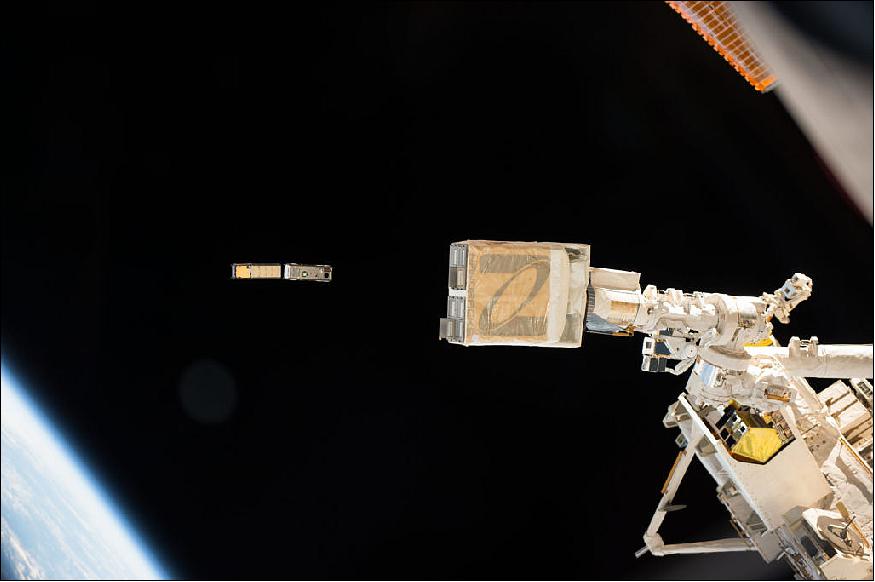
Sensor Complement
The QB50 constellation boards a set of science sensors to perform a detailed investigation of the mid-lower thermosphere. Among these sensors are: FIPEX (Flux-Φ Probe EXperiment), INMS (Ion and Neutral Mass Spectrometer), and m-NLP (multi Needle Langmuir Probe).
FIPEX (Flux (Phi Φ=flux) Probe EXperiment)
FIPEX, developed at the TU (Technical University) Dresden, Germany, is able to measure the time resolved behavior of atomic oxygen as a key parameter of the lower thermosphere. Atomic oxygen is the dominant species in these regions and therefore its measurement is crucial in the correlation and validation of atmosphere models. Moreover, erosion of spacecraft surfaces due to interaction with atomic oxygen is a serious concern and merits in-situ study in its own right. 12)
The measurement is based on solid oxide electrolyte micro-sensors. For oxygen conducting solid state electrolytes, e.g. yttrium-doped zirconia, the conductivity starts at high temperatures and so the sensor operates at an elevated temperature of 600-700ºC, heated by an electrical resistance. Oxygen is "pumped" from one electrode to the other by an applied direct voltage at tree electrode polarization control and in accordance with Faraday's law; the measured current in is proportional to the mass flux by electrolysis. To distinguish between atomic oxygen (AO) and molecular oxygen (O2) sensor elements with different cathode materials being used.
The sensor needs to be in free flow and to determine the actual flux the attitude of the satellite with respect to its direction of motion needs to be known.

FIPEX in general is able to distinguish and to measure atomic and molecular oxygen at very low ambient pressures (down to 10-10 mbar partial pressure). The objective of the FIPEX on CubeSats is to measure the time resolved behavior of atomic oxygen flux in-situ in the upper atmosphere and lower thermosphere based on solid oxide electrolyte micro-sensors. Especially the flux of atomic oxygen is of general importance as it shows different interactions with spacecraft surfaces, e.g. erosion of the surface materials. Furthermore, using the atmosphere models, the prediction of total density and the partial pressures in higher latitudes are insufficient. It is well documented in the literature that the main models of the upper thermosphere (e.g. NRLMSISE, DTM, METM) show significant deviations in the prediction of the residual species over time, altitude and longitude of up to 470 percent.
The sensor is based on the amperometric three electrode principle where the electrical current is measured along the electrochemical polarization control on a noble metal ceramic compound heated to approximately 660°C. According to Faraday's law, this current is proportional to the mass flux by electrolysis. Thus, oxygen is non-dissociative adsorbed and transformed to oxygen ions under a potentiometric-Nernst-principle polarization control. These ions are conducted through the solid electrolyte towards the anode, where they recombine to oxygen molecules. Additionally, a diffusion barrier limits the oxygen flux to the cathode.
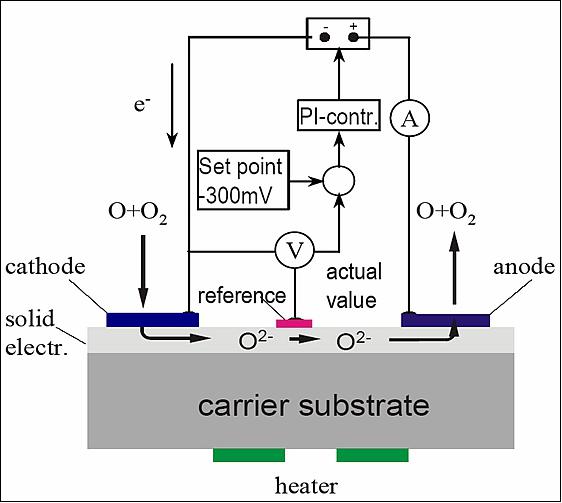
If this flux limitation is high enough, the oxygen partial pressure almost vanishes at the cathode. In this particular case, the measured current is limited directly by the diffusion of the oxygen to the cathode and therefore a linear dependence on the oxygen partial pressure is achieved due to the diffusion law. Under low-pressure conditions, e.g. in LEO (Low Earth Orbit) the oxygen molecule flux is naturally limited by effusion laws. In order to distinguish the atomic oxygen (AO) from the molecular oxygen (O2) different cathode materials are used.
INMS (Ion and Neutral Mass Spectrometer)
INMS, developed at MSSL (Mullard Space Science Laboratory) of the University College London, UK, is a miniaturized analyzer designed for sampling of low mass ionized and neutral particles in the spacecraft ram direction with the instrument resolutions optimized for resolving the major constituents in the lower thermosphere, i.e., atomic oxygen (O), molecular oxygen (O2), nitrogen monoxide (NO) and nitrogen (N2). The key sensor components consist of a collimator/ion filter, an ionizer and a charged particle spectrometer. Particles enter the aperture into the ion filter region where charged particles can be rejected. This is followed by a series of baffles for collimation and further charged particle suppression. Collimated neutral particles are subsequently ionized in the ionizer by a 50 eV electron beam followed by mass selection in the analyzer. With an energy resolution of 3%, the analyzer provides clean separation of the major constituents. The spectrometer can be operated in different modes, optimized for ions or neutral particle analysis. The INMS science unit operates in a single mode although this mode is largely configurable by script commands from the CubeSat onboard computer depending on the science requested.
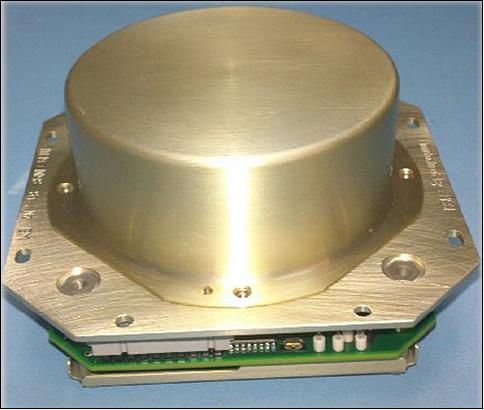
m-NLP (Multi Needle Langmuir Probe)
m-NLP works by measuring the current collected individually from four needle probes, placed in front of the satellite's shock front. The collected current is converted to voltage, filtered, digitalized and then sent to the central telemetry (TM) system. By using data from four fixed-bias Langmuir needle probes, sampled at the same time, the plasma electron density can be derived with high time resolution without the need to know the electron temperature and the spacecraft potential. With the selected needle probe design and the estimated electron densities, the instrument is to be capable of measuring currents ranging from 350 pA to 3.8 µA. The m-NLP system consists of one data acquisition PCB (Printed Circuit Board), one PCB which acts as the mounting plate for the m-NLPs, one aluminum top plate and an integrated electron emitter. 13)

Background of the m-NLP development in Norway: For the last 13 years, UIO (University of Oslo) developed a new Langmuir probe system for high spatial resolution measurements of ionospheric electron density, together with measurements of the spacecraft floating potential. The system consists of four miniaturized cylindrical Langmuir probes, and is therefor referred to as the multi-Needle Langmuir Probe system (m-NLP).
The system was tested on six sounding rockets flights from 2003 – 2012 to altitudes of 350 km, and several upcoming CubeSat missions will have the m-NLP system as the science payload, i.e. the QB50 multi-satellite mission. The advantages of the m-NLP system, compared to other Langmuir probes, are the unprecedented high sampling rate, and the capability of on-board processing of electron density and spacecraft floating potential with low computational power requirements. For the spacecraft operators this means that they can get valuable info on the plasma conditions around the satellite, as well as the spacecraft charging levels. Both at low telemetry cost, and with high time resolution.
The company EIDEL (Eidsvoll Electronics AS) of Norway is space qualifying the m-NLP system for 10 years of operation on satellites in LEO (Low Earth Orbit). The instrument unit was designed and space qualified by EIDEL, while the boom system was developed by the University of Oslo. The intended operational environment for the m-NLP system is LEO up to 1000 km altitude. 14)
The space qualification of the multi-Needle Langmuir Probe system was funded by the ESA GSTP (General Support Technology Program) under ESA Contract No. 4000109398/13/NL/AK. The project is running from November 2013 to delivery of the EQM (Engineering Quality Model) in 2017.
QB50 CubeSat Constellation Background
The QB50 CubeSat constellation is an international cooperative initiative, coordinated by the VKI (Von Karman Institute for Fluid Dynamics) in Brussels, Belgium, and comprises a team of 11 partners. The initiative aims at launching a network of 50 CubeSats to orbit in the lower thermosphere region for three months and perform in-situ measurements.
The QB50 project, which was initiated in 2009, is supported by the EU's 7th Framework Program (FP7). The Research Executive Agency (REA) manages the project on behalf of the European Commission. The objective of the QB50 project is to achieve sustainable and affordable access to space for small scale scientific and technology space missions. The work on the QB50 project began in November 2011 with the kick-off meeting, when the call for proposals was made public for the interested institutions to apply.
The QB50 project has the scientific objective of studying in-situ the temporal and spatial variations of a number of key parameters in the lower thermosphere (between 330 and 90 km altitude) with a network of about 50 CubeSats, separated by a few hundred km and carrying identical sensors.
A secondary objective is to study the atmospheric entry process by measuring a number of key parameters during reentry and by comparing predicted and actual CubeSat trajectories and orbital lifetimes. Initially, the objective was to launch all 50 CubeSats on a single launch vehicle into a circular orbit at about 330 km altitude, and at an inclination of 79º. Due to atmospheric drag the orbits of the CubeSats will decay and progressively lower and lower layers of the thermosphere will be explored, perhaps down to 90 km, without the need for on-board propulsion. 15) 16) 17) 18) 19) 20) 21) 22) 23) 24) 25) 26) 27) 28) 29)
The lower thermosphere (up to about 350 km) is one of the least explored layers of the atmosphere. It is too high for stratospheric balloons (max altitude 42 km) and too low for satellites due to drag by the residual atmosphere. Remote-sensing by ground based lidars and radars are operational up to 105 km. On the other hand, remote-sensing by Earth observation satellites in higher orbits (600 – 800 km) mainly observe constituents in the troposphere, stratosphere and mesosphere. The lower thermosphere is too rarefied for the remote-sensing satellites to perform accurate measurements. In-situ measurements by sounding rockets in the MLT (Mesosphere and Lower Thermosphere) region provide only occasional (a few times per year) single point measurements and they only last a couple of minutes. All atmospheric models, and ultimately numerous users of these models, would greatly benefit from actual in-situ measurements obtained by a network of CubeSats in the MLT region.
Space agencies are not pursuing a multi-spacecraft network for in-situ measurements in the lower thermosphere because the cost of a network of 50 satellites built to industrial standards would be extremely high and not justifiable in view of the limited orbital lifetime. No atmospheric network mission for in-situ measurements has been carried out in the past or is planned for the future. A network of satellites for in-situ measurements in the lower thermosphere can only be realized by using very low-cost satellites, and CubeSats are the only realistic option. 30)
The QB50 constellation will consist of 50 double CubeSats (10 cm x 10 cm x 20 cm), with 1U providing the usual satellite functions and the other 1U accommodating a set of identical sensors for lower thermosphere and reentry research.
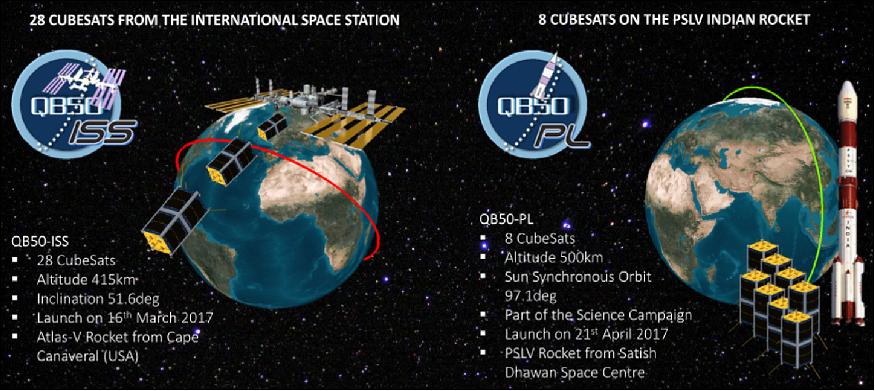
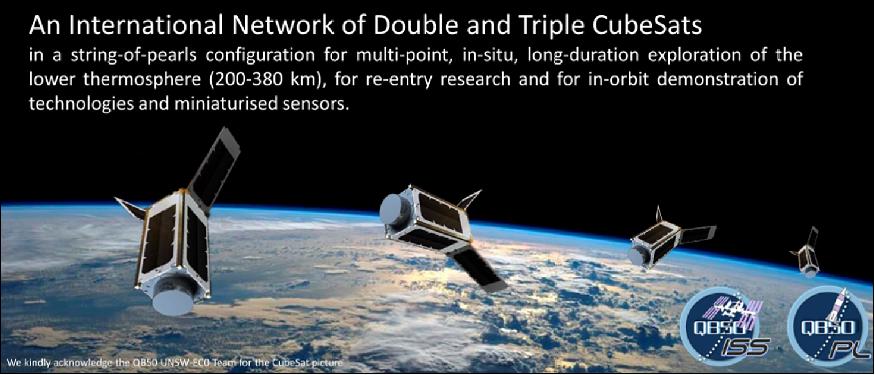
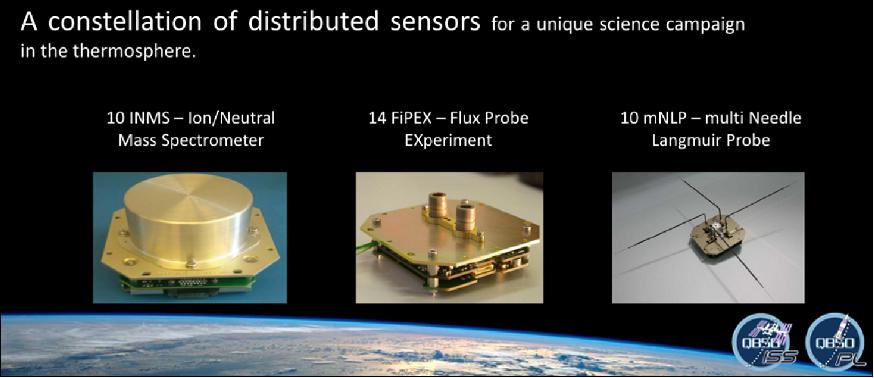
QB50 Project Development Status
• December 9, 2016: Two weeks ago, the launch preparation activities managed by VKI/ISIS/NanoRacks were successfully concluded at ISIS (Innovative Solutions In Space B.V.) facilities. Twenty-eight (28) CubeSats of the QB50 constellation, were integrated into eleven (11) NanoRacks 6U deployers. After a formal handover of the hardware to NanoRacks LLC, the CubeSats and the deployers were shipped to NanoRacks's facilities in Houston (Texas, US). Today the hardware has been cleared out at the US customs and then it will be transported to the cleanroom of NanoRacks. In a window of time between Dec 19th 2016 to Jan 9th 2017 all deployers will be finally delivered to Lockheed Martin which is responsible for the CMC (Cargo Mission Contract). 32)
- From there on, Lockheed Martin will be in charge of loading the deployers into the Cygnus CRS OA-7 Cargo for a launch atop an Atlas V from Cape Canaveral SLC-40 on March 16th 2017 (date/time to be confirmed).
• March 9, 2016: NanoRacks of Houston, Texas, has been selected as a launch integration and deployment partner for the QB50 CubeSat Constellation Mission. NanoRacks will be deploying a majority of the QB50 satellites from the International Space Station (ISS) utilizing the Company's NanoRacks CubeSat Deployer (NRCSD). The selection of the ISS as the deployment platform for this program leverages the unique capabilities of the ISS to serve as a test-bed for numerous in-space technologies and research development. 33)
• January 29, 2016: The QB50 project has shifted plans from launching with the Brazilian-Ukrainian Cyclone 4 rocket to instead launching with NanoRacks and Kosmotras. The mission, scheduled to begin this year, split into a series of multiple launches after Alcantara Cyclone Space's Cyclone 4 project stalled out. 34)
- "We will be launching 40 satellites from the International Space Station (ISS) through services provided by NanoRacks," Jan Thoemel, project manager for QB50, told Via Satellite. "[And] we will carry out two Dnepr campaigns. One is optimal for our scientific objective and the other one ... is perfect for two in-orbit demonstration satellites."
• QB50 Precursor mission: On June 19, 2014, the QB50 project launched two precursor CubeSats into orbit. The QB50P1 and QB50P2 2U CubeSats were launched as secondary payloads on a Dnepr-1 vehicle of ISC Kosmotras. The launch site was the Yasny Cosmodrome in the Dombarovsky region of Russia. — The two primary payloads on the flight were Deimos-2 minisatellite (310 kg) of Deimos, Spain, and KazEOSat-2, an imaging minisatellite (185 kg) of KGS (Kazakhstan Gharysh Sapary), Astana, Kazakhstan. 35) 36)
QB50 P1 | QB50P2 |
INMS Payload from MSSL, UK | FIPEX Payload, University of Dresden, Germany |

• Status: The two QB50P1 and QB50P2 nanosatellites experienced high tumble rates after deployment (~30º/s, much higher than expected); however, successful recovery from the tumble rates. Both satellites were placed into a controlled Y-Thomson spin. 38)
- RF link: Both satellites have a strong signal in downlink. The commandability in uplink is good.
- CDHS stability: The QB50P2 is stable; the QB50P1 suffers from I2C "hangs" (on average ~5 times/day).
- Thermal status: Panel temperatures between -25ºC and 40ºC. Satellite internal temperatures mostly between -10ºC and 30ºC.
- Power status: Positive power margin, batteries are fully charged.
References
1) "NanoRacks-QB50 (NanoRacks-QB50)," NASA, April 5, 2017, URL:
https://www.nasa.gov/mission_pages/station/research/experiments/2539.html
2) "NASA Space Station Cargo Launches aboard Orbital ATK Resupply Mission," NASA, Release 17-029, April 18, 2017, URL: https://www.nasa.gov/press-release
/nasa-space-station-cargo-launches-aboard-orbital-atk-resupply-mission
3) "Mission Page: OA-7 Space Station Cargo Resupply," Orbital ATK, April 18, 2017, URL: https://web.archive.org/web/20170224064116/https://www.orbitalatk.com/news-room/feature-stories/OA7-Mission-Page/default.aspx?prid=180
4) Davide Masutti, "QB50-ISS CubeSats ready to be launched," Dec. 9, 2016, URL: https://www.qb50.eu/index.php/news/78-qb50-iss-ready-to-be-launched
5) US Commercial ELV Launch Manifest, March 5, 2017, URL: http://www.sworld.com.au/steven/space/uscom-man.txt
6) "CubeSats Participating in the QB50 Project," List of participants in the QB50 project, 9 March 2017, URL: https://www.qb50.eu/index.php/community
7) "A Big Dream for Israeli High School Students' SmallSat is Successful," Satnwes Daily, April 24, 2017, URL: http://www.satnews.com/story.php?number=888654511
8) Andrew Dempster, "Australia's back in the satellite business with a new launch," Space Daily, April 20, 2017, URL: http://www.spacedaily.com/reports
/Australias_back_in_the_satellite_business_with_a_new_launch_999.html
9) "NanoRacks-QB50," NASA, March 15, 2017, URL:
https://www.nasa.gov/mission_pages/station/research/experiments/2539.html
10) "NanoRacks Completes Largest ISS CubeSat Deployment Cycle To Date," NanoRacks, May 26, 2017, URL: http://nanoracks.com/wp-content/uploads
/NanoRacks-Release-65-Largest-ISS-CubeSat-Deployment-Cycle-To-Date.pdf
11) "NanoRacks CubeSat Deployer Mission 11 Status Update: Good Deploy!," NanoRacks, May 17, 2017, URL: http://nanoracks.com/cubesat-deployer-mission-11-update/
12) "Manual for the FIPEX on QB50 Science Unit, PART: Flight Model," TU Dresden, December 1, 2014, Issue: 2.0.1, URL: https://www.qb50.eu/index.php/tech-docs/category
/18-old-docs?download=84:fipex-user-manual
13) T. A. Bekkeng, "mNLP User Manual," University of Oslo, Doc. No. QB50-mNLP-UiO-UM-0001 Iss. A, 5 March 2015, URL: https://www.qb50.eu/index.php/tech-docs/category
/23-up-to-date-docs?download=95:mnlp-user-manual
14) "Multi-Needle Langmuir Probe(m-NLP)," EIDEL, URL:
http://eidel.no/products/multi-needle-langmuir-probe-m-nlp/
15) Jean Muylaert, Ruedeger Reinhard, Cem Ozan Asma, "QB50: An International Network of 50 CubeSats for Multi-Point, In-Situ Measurements in the Lower Thermosphere and Re-Entry Research," Proceedings of the Symposium on Small Satellite Systems and Services (4S), Funchal, Madeira, Portugal, May 31-June 4, 2010
16) J. Muylaert, R. Reinhard, C. Asma, "QB50 An international network of 50 double CubeSats for multi-point, in-situ, long-duration measurements in the lower thermosphere and for re-entry research," Proceedings of the 7th Annual CubeSat Developers' Workshop, CalPoly, San Luis Obispo, CA, USA, April 21-23, 2010
17) P. P. Sundaramoorthy, E. Gill, C. J. M. Verhoeven, J. Bouwmeester, "Two CubeSats with Micro-Propulsion in the QB50 Satellite Network," Proceedings of the 24th Annual AIAA/USU Conference on Small Satellites, Logan, UT, USA, Aug. 9-12, 2010, SSC10-III-3
18) Robert Twiggs, Benjamin Malphrus, J. Muylaert, "The QB50 Program, the first CubeSat Constellations doing Science," Proceedings of the 24th Annual AIAA/USU Conference on Small Satellites, Logan, UT, USA, Aug. 9-12, 2010, SSC10-XII-3
19) Stefano Speretta, Wouter Weggelaar, Abe Bonnema, Joost Elstak, "Challenges of operating the QB50 nanosatellite swarm," Proceedings of IAC 2011 (62nd International Astronautical Congress), Cape Town, South Africa, Oct. 3-7, 2011, paper: IAC-11.B4.3.2
20) Inés Ortega Castelló, Ramón Martínez-Rodríguez Osorio, "Study of the Ground Segment for a Nanosatellite Constellation," Proceedings of the 4S (Small Satellites Systems and Services) Symposium, Portoroz, Slovenia, June 4-8, 2012
21) Alan Smith, "QB50 Sensor Selection Working Group (SSWG)," Final Report, March 19, 2012, URL: https://www.qb50.eu/sswg_report.pdf
22) "Second QB50 Workshop," VKI, Brussels, Belgium, 27-28, 2012, URL: https://www.qb50.eu/index.php/events/15-second-qb50-workshop
23) E. Gill, J. Guo, J. Bouwmeester, B. Zandbergen, "DelFFi: Formation Flying within the QB50 Constellation of Nano-Satellites," Proceedings of the 63rd IAC (International Astronautical Congress), Naples, Italy, Oct. 1-5, 2012, paper: IAC-12.B4.7B.5
24) Ruedeger Reinhard, Cem O. Asma, Jean Muylaert, "The QB50 Project: A network of 50 CubeSats," Proceedings of the UN/Japan Workshop and The 4th Nanosatellite Symposium (NSS), Nagoya, Japan, Oct. 10-13, 2012, paper: NSS-04-0107
25) J. Muylaert, "QB50 - An international network of CubeSats," Proceedings of the 50th Session of Scientific & Technical Subcommittee of UNCOPUOS, Vienna, Austria, Feb. 11-22, 2013, URL: http://www.oosa.unvienna.org/pdf/pres/stsc2013/tech-26E.pdf
26) Xiaozhou Yu, Jun Zhou, Yao Zhang, Liuyu Zhu, "The QB50 Project and the Participation of Chinese Universities," Proceedings of the 64th International Astronautical Congress (IAC 2013), Beijing, China, Sept. 23-27, 2013, paper: IAC-13-B4.4.3
27) Fiona Singarayar, R. Reinhard, C. Asma, J. Thoemel, T. Scholz, C. Bernal, W. Weggelaar, G.Shirville, D. Kataria, M. Richard, "QB50 System Requirements and Recommendations," Issue 4, July 5, 2013, URL: https://www.qb50.eu/index.php/tech-docs/category
/5-qb50-system-requirements-document?download=30:qb50_docs
28) Lourens Visagie, "QB50 ADCS Interface Control Document," Version 3.0, Release: June 18, 2014, URL:
https://www.qb50.eu/index.php/tech-docs/category/2-adcs?download=57:adcs-icd-v3
29) J. Thoemel, F. Singarayar, T. Scholz, D. Masutti, P. Testani, C. Asma, R. Reinhard, J. Muylaert, "Status of the QB50 Cubesat Constellation Mission," Proceedings of the 65th International Astronautical Congress (IAC 2014), Toronto, Canada, Sept. 29-Oct. 3, 2014, paper: IAC-14-B4.2.11, URL:
https://www.qb50.eu/index.php/tech-docs/category/26-ref?download=97:iac-14-b4-2-11
30) https://www.qb50.eu/index.php/project-description-obj/mission-objectives
31) URL: https://www.qb50.eu/index.php/events/15-second-qb50-workshop
32) Davide Masutti, "QB50-ISS CubeSats ready to be launched," VKI, Dec. 9, 2016, URL: https://www.qb50.eu/index.php/news
33) "NanoRacks to Deploy QB50 Satellites from International Space Station," NanoRacks,Press Release , March 9, 2016, URL: http://nanoracks.com/wp-content/uploads
/NanoRacks-Release-46-NanoRacks-To-Deploy-QB50-Satellites-from-ISS.pdf
34) Caleb Henry, "QB50 Launch Switches from Alcantara Cyclone Space to NanoRacks and Kosmotras," Via Satellite, January 29, 2016, URL: http://www.satellitetoday.com/launch/2016/01/29
/qb50-launch-switches-from-alcantara-cyclone-space-to-nanoracks-and-kosmotras/
35) William Graham, "Russian Dnepr rocket lofts record haul of 37 satellites," NASA Spaceflight.com, June 19, 2014, URL:
http://www.nasaspaceflight.com/2014/06/russian-dnepr-rocket-record-launch-37-satellites/
36) "Two QB50 satellites with ham radio payloads delivered," AMSAT-UK, May 4, 2014, URL:
https://amsat-uk.org/2014/05/04/two-qb50-satellites-with-ham-radio-payloads-delivered/
37) "ISIS delivers the first two QB50 satellites as part of the EU FP7 QB50 project," 12 June 2014, URL:
https://www.qb50.eu/index.php/news
/72-isis-delivers-the-first-two-qb50-satellites-as-part-of-the-eu-fp7-qb50-project
38) Z. De Groot, J. Elstak, E. Bertels, J. Rotteveel, "The QB50 precursor flight: Status, preliminary results and lessons learned," 6th European CubeSat Symposium, Estavayer-le-Lac, Switzerland, October 14-16, 2014
39) Garcia, Mark. “Partners Extend International Space Station for Benefit of Humanity – Space Station.” NASA Blogs, 27 April 2023, https://blogs.nasa.gov/spacestation/2023/04/27/partners-extend-international-space-station-for-benefit-of-humanity/
The information compiled and edited in this article was provided by Herbert J. Kramer from his documentation of: "Observation of the Earth and Its Environment: Survey of Missions and Sensors" (Springer Verlag) as well as many other sources after the publication of the 4th edition in 2002. - Comments and corrections to this article are always welcome for further updates (eoportal@symbios.space).
Launch Mission Status Sensor Complement Background of the QB50 CubeSat Constellation References Back to top